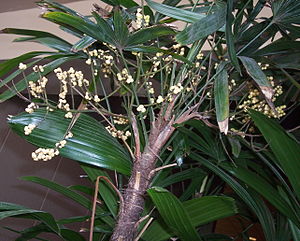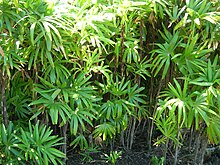Rhapis
| Rhapis | ||||||||||||
|---|---|---|---|---|---|---|---|---|---|---|---|---|

|
||||||||||||
| Systematics | ||||||||||||
|
||||||||||||
| Scientific name | ||||||||||||
| Rhapis | ||||||||||||
| Lf ex Aiton |
Rhapis is a genus of the palm family native to Southeast Asia. The genus is characterized by leaves that are divided into segments between the folds, not along the folds, as is common with palms. Several species are used as ornamental plants .
features
The representatives are slender, multi-stemmed fan palms . They are diocesan or, more rarely, polygamous. The trunk is tubular, upright and covered with leaf sheaths.
The leaves are fan-shaped and folded induplicate. The petiole is long and slender, the edge smooth or slightly rough. The hastula on top is small and triangular, an abaxial hastula is missing. The fully grown leaf blade is glabrous and divided into segments between the folds that include several ribs. The larger incisions reach up to a third of the leaf radius or all the way to the middle. The tips of the segments are further slightly incised.
The inflorescence stands between the leaves, male, female and hermaphrodite inflorescences are similar to each other. An inflorescence is branched one to three times. The cover sheet is Roehrig and two-keeled. It tears open along the abaxial midline. The inflorescence stalk is usually completely enclosed in the leaf sheath, bracts on it are missing. The inflorescence axis is longer than the stalk. On the axis there are one to three, rarely four, large, single-keeled bracts with leaf sheath, which carry the side axes of the first order. The flower-bearing axes (Rachillae) are soft, protruding, which are sometimes sometimes densely packed. There are individual flowers in a spiral arrangement, rarely pairs of flowers in the axils of very small bracts .
There are male, female, and hermaphrodite flowers that are similar to each other. The calyx is cup-shaped, three-lobed with sometimes irregular lobes. The crown is fleshy, tubular and three-lobed, usually with a stem-like base consisting of receptaculum and crown. There are six stamens or staminodes in two circles. In the male flowers, the filaments are fused with the corolla tube almost along the entire length and only free at the tips. The anthers are basifix, short and rounded. The pollen is elliptical, monsulcat with a fine reticulate surface. The stamp rudiment is very small. The female flowers have six staminodes. The three carpels are wedge-shaped, each has a short stylus with a cylindrical scar . Each carpel contains an ovule . This seat basal, is hemanatrop and carries at the base a fleshy aril .
The fruit develops from only one carpel, less often from two or three. The fruit is stalked, and there is a scar residue at the tip of the fruit. The exocarp is papillary, the mesocarp is fibrous, and the endocarp is thin. The seed has a short lateral raphe . The endosperm is homogeneous.
The number of chromosomes is 2n = 36. There are also tetraploid clans with 4n = 72.
Distribution and locations
Rhapis occurs from southern China to the south via Indochina to the Thai peninsula. One species occurs in the northernmost part of Sumatra . The representatives grow in the undergrowth of tropical, evergreen forests. Rhapis subtilis and other species appear to be restricted to sandstone hill country.
Systematics
The genus Rhapis L.f. ex Aiton is placed within the family Arecaceae in the subfamily Coryphoideae , the tribe Trachycarpeae and the subtribe Rhapidinae . The monophyly of the genus has not yet been investigated. Her sister group is likely to be Guihaia .
The Royal Botanic Gardens, Kew's World Checklist of Selected Plant Families recognizes the following species:
- Rhapis evansii A.J.Hend. : The species first described in 2016 occurs in Laos.
- Rhapis excelsa (Thunb.) A. Henry : It is native to southern China and northern to central Vietnam.
- Rhapis gracilis Burret : The home is southeast China to Vietnam.
- Rhapis humilis flower (Syn .: Rhapis multifida Burret ): The homeland are the provinces of southeastern Yunnan, Guizhou and Guangxi in China.
- Rhapis kebangensis A.J.Hend. : The species first described in 2016 occurs in Vietnam.
-
Rhapis laosensis Becc. : With two subspecies:
- Rhapis laosensis subsp. laosensis : It occurs in northeastern Thailand and Laos.
- Rhapis laosensis subsp. macrantha (Gagnep.) AJHend. : It occurs in northern and central Vietnam.
- Rhapis micrantha Becc. : The home is Laos and northwest Vietnam.
- Rhapis puhuongensis M.S. Trudgen, TPAnh & AJHend. : The species first described in 2008 only occurs in Vietnam.
- Rhapis robusta Burret : The home is Guangxi and northern Vietnam.
-
Rhapis subtilis Becc. (Syn .: Rhapis siamensis Hodel ): The home is Thailand, Cambodia, Laos and Sumatra. With two subspecies:
- Rhapis subtilis subsp. siamensis (Hodel) AJHend. : It occurs in Thailand and in western Sumatra.
- Rhapis subtilis subsp. subtilis : It occurs in Thailand, Laos and Cambodia.
- Rhapis vidalii Aver., THNguyên & PKLôc : The species, which was first described in 2006, only occurs in northern Vietnam.
No longer counted in this genus:
- Rhapis cochinchinensis (Lour.) Mart. => Livistona saribus (Lour.) Merr. ex A.Chev.
use
Several species are used as ornamental plants. Engelbert Kaempfer already described the cultivation of Rhapis excelsa in Japan, where the species is not native , from his trip 1690–92 . The first plants came to Europe through James Gordon in 1774. Rhapis excelsa , Rhapis humilis and Rhapis subtilis are widely used as ornamental plants in the USA. In Japan there are several dwarf and variegated varieties of Rhapis excelsa and Rhapis humilis . Other species have been cultivated since the 1960s.
The logs are made into sticks and umbrellas.
literature
- John Dransfield, Natalie W. Uhl, Conny B. Asmussen, William J. Baker, Madeline M. Harley, Carl E. Lewis: Genera Palmarum. The Evolution and Classification of Palms . Second edition, Royal Botanic Gardens, Kew 2008, ISBN 978-1-84246-182-2 , pp. 226ff.
- Laura H. Hastings: A Revision of Rhapis, the Lady Palms . Palms, Vol. 47, 2003, pp. 62-78.
Individual evidence
- ↑ a b c d e f g h i j k l Rafaël Govaerts (Ed.): Rhapis. In: World Checklist of Selected Plant Families (WCSP) - The Board of Trustees of the Royal Botanic Gardens, Kew . Retrieved August 3, 2018.
Web links
- Rhapis on the website of the Fairchild Tropical Botanic Garden

